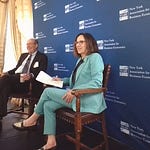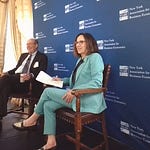Steven Blitz is certain the Federal Reserve is going to cut its key rate in September, not only because inflation data continue to show deceleration and the jobs numbers show some weakening. He is backing up his forecast with a look back over the Fed’s messaging from the time it started hiking rates in 2022 to now, and looking at the strategy it has been following.
|In Steve’s view, Powell has made it clear that once inflation peaked and started coming down, if the Fed did not start cutting rates, its policy would become tighter and tighter. So with the fed funds rate at 5-1/4-5-1/2 percent, and inflation roughly around 3% if the Fed does not start cutting rates now it risks a dangerously sharp slowdown later.
So what’s the Fed’s immediate plan of action now? He says it’s to make it clear at the July meeting that it’s ready to do its first rate cut of this cycle at the September meeting. One 25 bps cut is what he sees, with three more after that, timing to be determined the data.
When I asked if he thinks Chair Powell will use his speech at the Kansas City Fed’s Annual Jackson Hole Symposium to outline a bigger framework for the path and dynamics of the rate cuts ahead, Steve said, No.
He expects Powell to take up the very important issue of Fed Independence as the central bank comes under fire from many different directions. It’s well worth hearing this part of the interview too as Steve puts this in historical perspective going back to the eras before Paul Volker crushed the economy to crush in inflation, and argues that the Volcker era of Fed independence is ending now, to be replaced by the model of past eras when the Fed secondary to and answerable to the White House.
So take a seat and hear and see that he has to say. You will be glad you did.
Before you do, here’s more about Steve. Starting in the 70’s his professional experience as economist and portfolio managers includes work at Data Resources Inc., Salomon Brothers, OFFITBANK, Lazard Asset Management and, more recently, as Chief Economist at M Science he developed “big data” to underpin his analysis of the economy, central bank policies, and capital market pricing.













Share this post